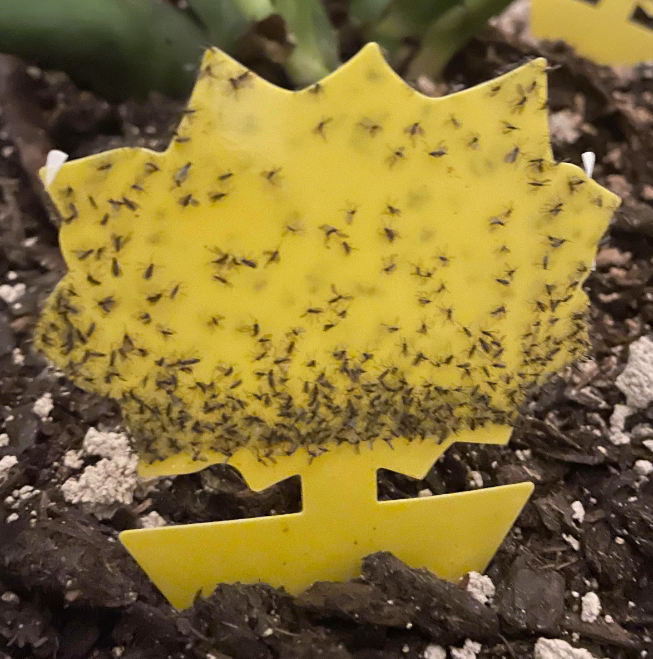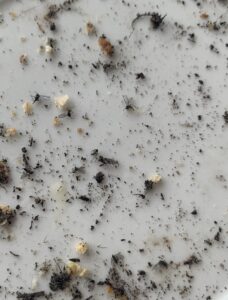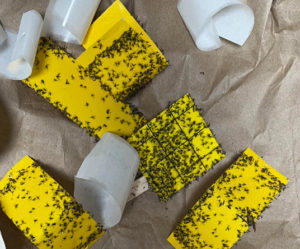If you come across small flying gnats in your semi-hydroponic space, it could be an indication of a fungus gnat infestation. These pests are sneaky and can go unnoticed until your plants begin to show signs of distress. Although adult gnats may appear to be harmless, it is their larvae that can cause significant damage to your garden.
Summary
How to deal with Fungus Gnats in Semi-Hydroponics
- Identification: Tiny gnats around plants suggest fungus gnat infestation.
- Sources: Enter from outdoors or infested plants, breeding in moist, organic material.
- Impact: Larvae damage plant roots, leading to nutrient deficiencies and disease.
- Detection: Look for gnats and larvae near plant bases and in grow mediums.
- Prevention: Enclose garden, inspect new plants, and remove dead matter and algae.
- Control: Use sticky traps, diluted hydrogen peroxide, and commercial products like Tanlin.
- Lifecycle: Includes egg, larva, pupa, and adult stages. Target control methods accordingly.
- Key Strategy: Early detection and targeted intervention for a healthy garden.
Understanding the Fungus gnats

Fungus gnats can invade your semi-hydroponic garden from outdoors or hitch a ride on already-infested plants.
They breed by laying eggs in dead plant debris, algae, or the damp surroundings of your plants’ roots.
Lifecycle and Behavior of Fungus Gnats
Understanding the lifecycle of fungus gnats is key to controlling their presence in your semi-hydroponic garden, whether it is LECA, Pon, or Pumice. Fungus gnats go through four main stages: egg, larva, pupa, and adult.
- Egg: The female gnat lays her eggs in moist, organic-rich environments, often in the top layer of the growing medium. These eggs hatch within a few days.
- Larva: The larvae feed on organic matter, including algae, fungi, and plant roots, for about two weeks before transitioning into the pupal stage. This is the stage where they cause the most harm to plants.
- Pupa: The pupal stage lasts about a week, during which the larva transforms into an adult.
- Adult: Adult gnats have a short lifespan of about a week, during which their primary objective is reproduction.
Recognizing these stages can help you target interventions more effectively, for example, focusing on adult gnats to prevent egg laying or targeting larvae to prevent damage to your houseplants.
Environmental Factors Favoring Fungus Gnats
Fungus gnats thrive in warm, humid environments, which are often found in semi-hydroponic systems. Key factors that attract and sustain these pests include:
- Moisture: Overwatering or poor drainage creates ideal conditions for gnats to breed.
- Organic Matter: Decomposing plant material or algae provides food for larvae.
- Temperature: Temperatures between 70°F and 80°F (21°C to 27°C) are ideal for their growth and reproduction.
Managing these environmental factors is crucial. Ensure good air circulation, adjust watering schedules to avoid excessive moisture, and regularly clean and remove any decaying plant matter.
The Impact of Fungus Gnats on Semi-Hydroponics

Each fungus gnat is capable of laying hundreds of eggs. Once hatched, their larvae feast on the roots of your plants.
This not only damages the root system but also exposes the plants to harmful viruses and pathogens.
Without intervention, these pests can rapidly multiply and overwhelm your semi-hydroponic garden.
Plants under attack from fungus gnats often display symptoms of nutrient deficiencies due to their compromised root systems.
Identifying Fungus Gnat Presence
Spotting fungus gnats in your semi-hydroponic garden is a clear sign of infestation.
These pests are often seen flying around plants or resting on leaves, and they are particularly drawn to the grow medium and plant bases.
The larvae, which are more damaging, typically remain hidden beneath the grow medium and can go unnoticed initially.
If you disturb the grow medium at your plant’s base and notice gnats or their larvae amidst discolored roots, it indicates a deep-rooted infestation.
Another tell-tale sign is the presence of larvae in algae that may form on your grow medium or within the reservoir. Regularly clearing any algae build-up is crucial.
How to Prevent Fungus Gnat
The best strategy to avert fungus gnat problems is prevention.
Enclosing your semi-hydroponic garden is highly effective. Ensure any vents leading outdoors have filters to block these tiny pests.
If your garden is in an open area of your home, keep window screens intact and minimize leaving doors open.
Be vigilant with new additions to your garden, such as clones or transplanted plants. These can unknowingly harbor gnat eggs or larvae. Inspect them thoroughly for any signs of pests.
Fungus gnats are attracted to dead plant matter and algae, so promptly removing these from your setup is essential.
Additionally, allow the top layer of your plant’s root zone to dry out between waterings, or maintain the top few inches of your grow medium dry to deter these gnats.

How to deal with Fungus Gnats
To eradicate fungus gnat larvae in your plant’s root system, there are a couple of effective methods:
Firstly, eliminate their primary food sources – any dead organic matter or algae in your garden.
Sticky Traps
Using sticky traps effectively traps adult gnats, preventing them from laying eggs in the plant’s root zone and stopping their life cycle.
Using Hydrogen Peroxide
A solution of 3% hydrogen peroxide, mixed at approximately 2 teaspoons per gallon, can help control fungus gnats and sterilize the area.
Begin with a lower concentration and gradually increase over a week or two.
However, be cautious, as hydrogen peroxide can potentially harm your plants if you use too much, making it a less preferred option.
Commercial Semi-Hydroponic Products
There are specialized products available designed for hydroponic systems to eliminate larvae.
Tanlin, for instance, is safe for your garden and can be used right up to harvest day. It’s user-friendly, efficient, and considering its effectiveness, could be worth the investment, especially if your garden is at serious risk from fungus gnats.
Frequently Asked Questions
Q: How do I know if the gnats in my garden are fungus gnats?
A: Fungus gnats are small, dark, and have a mosquito-like appearance. They are commonly found around moist plant soil or other organic materials.
Q: Can fungus gnats harm my plants?
A: Yes, while adult fungus gnats are mostly a nuisance, their larvae can damage the roots of young plants, leading to stunted growth and increased susceptibility to disease.
Q: Are chemical treatments necessary to get rid of fungus gnats?
A: Not always. Non-chemical methods like reducing moisture, using sticky traps, and introducing biological controls can be very effective. Chemical treatments should be a last resort due to potential harm to the plants and environment.
Q: How often should I check my semi-hydroponic garden for fungus gnats?
A: Regular monitoring, at least once a week, is recommended to quickly identify and address any signs of an infestation.
Conclusion
Dealing with fungus gnats can be challenging, but they are a controllable pest. Early detection and prompt action are crucial in saving your Semi-hydroponic garden from these unwelcome guests. Consistent vigilance and appropriate intervention can ensure the health and productivity of your garden.

